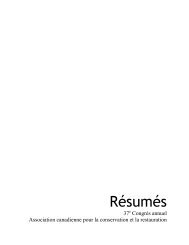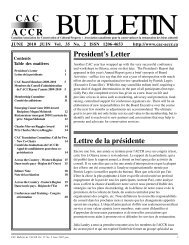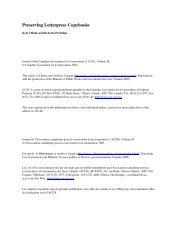Ottawa - Canadian Association for Conservation
Ottawa - Canadian Association for Conservation
Ottawa - Canadian Association for Conservation
Create successful ePaper yourself
Turn your PDF publications into a flip-book with our unique Google optimized e-Paper software.
Risk-based Thinking About Sustainability of Collections<br />
and of <strong>Conservation</strong><br />
R. Robert Waller, President and Senior Risk Analyst<br />
Protect Heritage Corp., <strong>Ottawa</strong>, ON<br />
The sustainability of the conservation profession is best pictured not as a goal but as a consequence<br />
of success. This paper considers the risk to the conservation profession, focusing on preventive<br />
conservation, and the application of more risk-based decision making approaches to preventive<br />
conservation.<br />
It is critical that the conservation field focuses ef<strong>for</strong>t clearly on our goal of preserving cultural<br />
property, while making that cultural property more accessible, and not become overly distracted<br />
in striving to reach a broad public. This is due to two fundamental issues: scale and uncertainty.<br />
Regarding scale, the conservation profession is small, actually tiny, in comparison with other<br />
professions. There are many benefits to being sensitive to, and striving to achieve, public education<br />
regarding the importance and value of conservation. Still, it is not at all reasonable to expect that<br />
we will be able to garner enough public awareness to make any significant difference in the viability<br />
of the conservation profession. Even if our profession were 1,000 to 10,000 times larger than it<br />
now is, relying on the direct education of the public as a primary means of improving the viability<br />
of the profession would be ill-advised. The greater the degree of separation of our supporters from<br />
our direct clients and employers, the more diluted their support is in its effectiveness. Not only is<br />
support diluted, but it is also uncertain whether it would have the intended effect in supporting the<br />
conservation profession as we know it.<br />
These are both simple and unavoidable consequences of the scale and complexity of networks. While<br />
it is emotionally appealing to think that massive public support could lead to a greater influence <strong>for</strong><br />
us in our daily work, it is most assuredly wishful thinking. At best it would distract us from what is<br />
most important, working effectively both with allied professionals and <strong>for</strong> our clients, be they private<br />
collectors, curators, managers, or whoever. Ultimately, it is our ability to work with those closest<br />
to us that will determine how sustainable the field of conservation will become. They need to see<br />
conservation as a unique and indispensable part of the mix in achieving their own professional goals.<br />
In the area of preventive conservation, the skills and abilities that ought to be most highly valued and<br />
are most uniquely associated with conservation are those that enable the effective management of<br />
resources <strong>for</strong> managing risk to collections. These capabilities are greatly enhanced by adoption of a<br />
properly-structured cultural property risk analysis model.





